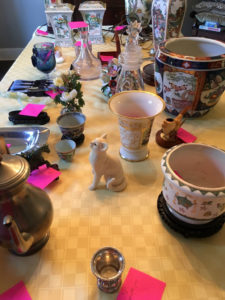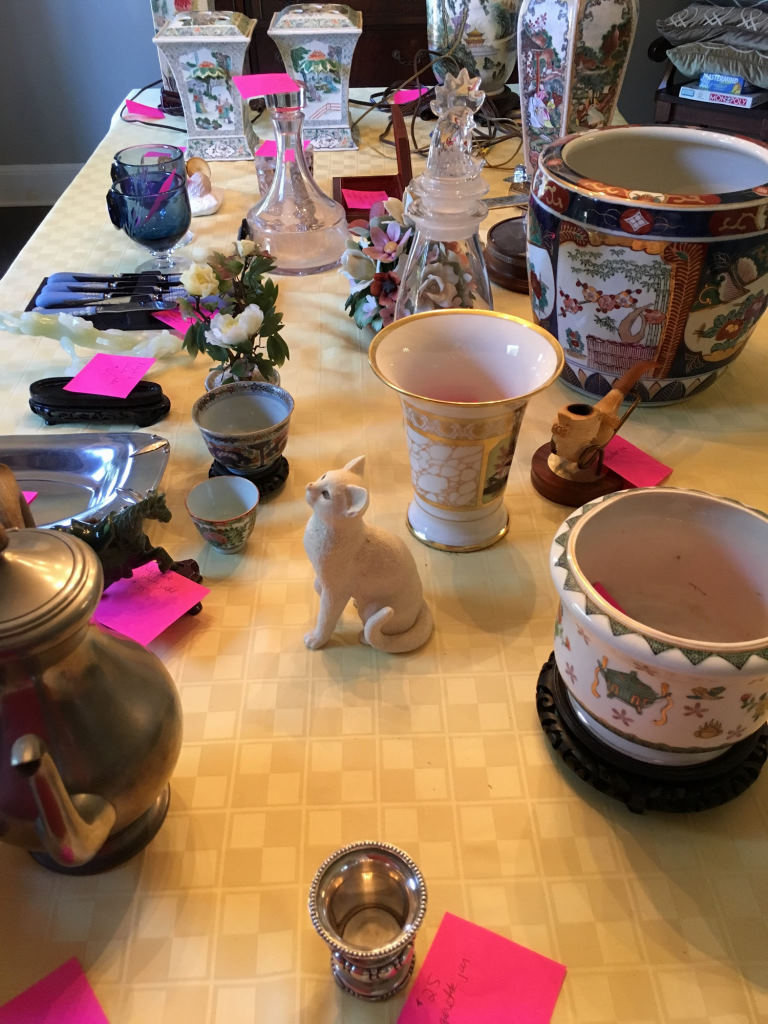
Who needs an auction house to sell Grandma’s antiques? Why share your profits? Why worry about making sure an auction house is reputable? Read issues you may encounter with auction houses. I hear stories all the time from families who were disappointed when they saw low turnout of potential buyers, high auction fees, and underwhelming auction results when selling. And, regularly I see–and most of you know this is true–very valuable objects selling for pennies on the dollar. Like I always say, buy at auction and get a bargain but sell at auction and you’ll lose your shirt.
For instance, I recently appraised a 150,000 dollar painting that was sold at an auction for only 5 dollars. 5 dollars. Can you afford to just give away your valuables? Why not host the auction yourself and bring more money home?
1. Do your Own Inventory
Why pay an auctioneer to inventory objects? While this process should be included in the auction’s fees, often times it is not. Some auction reps get the inventory process wrong too by misidentifying objects and undervaluing them. Hire an independent and unbiased appraiser–that’s me–with no involvement with auction houses to do the inventory. I am that appraiser, but feel free to find someone else who meets that criteria. Then, compare their education and experience with mine. Pay them a flat fee to identify and value every single thing. Never pay anyone a percentage of the appraised value. This practice is unethical and the IRS says that paying a percentage of the appraised value is unacceptable when receiving a formal appraisal.
I can help most people identify and value everything in a four- bedroom house in about one hour’s time. Watch me explain my in home antiques appraisals. Yes, sorting trash from treasure doesn’t have to be time consuming or costly. You just need the right expert. I make the process very easy for you so you don’t make the mistake of letting a pricey valuable go. I have seen auction houses make many object identification mistakes that can cost you a bundle. View valuables auctions houses missed.
2. Advertise Yourself
Now you have everything correctly identified and accurately valued in the current market, you now need to get the buyers to show up. One of the best ways to advertise your auction or sale yourself is to do exactly what you do every day… chat on social media. That’s right, tease your auction on all of your and your friends’ social media accounts. Get your family involved and ask them to spread the word, too. If they prefer to text, let them text about your auction or sale. Share pictures of sale items and the appraised values based on what people really pay that I provided during the inventory process (See #1 above). You regularly spend a good deal of time–sharing photos of your vacation, kids’ soccer games, and the YouTube channel of that very entertaining and knowledgeable Ph.D. Antiques Appraiser Dr. Lori on Facebook, Twitter and Instagram. Why not share photos of Grandma’s stuff that has been determined to be valuable?
Don’t forget about all those tech-savvy kids and millennials in your life. Millennials want durable, functional antiques to furnish and decorate their apartments and homes. See real examples of selling antiques to Millennials. Where do you find those Millennials? They are on social media.
3. Get Everybody Involved
Every family has that brother in law who isn’t afraid to get up in front of a crowd. They might even like to mix it up, telling family stories about each object or encouraging people to bid against each other. Have the people who have your family’s best interest at heart be your auctioneer. Or trade off and let a few outgoing family members and friends be the auctioneers throughout the day.
If you want to be fancy, your children or grandchildren can make numbered auction paddles out of popsicle sticks and construction paper. Kids can help by handing out forms to participants asking for a name, email address, and phone number in exchange for a numbered auction paddle to be sure everyone who is bidding is doing it the correct way.
For fun, you could ask friends to bring a dish (no, not a Limoges or Staffordshire dish) for a potluck picnic or party after the auction. Or, you could sell food and drinks which will bring in more cash for the cause too. If you make it festive, they will come and if it is available, they will buy. Use the information you got in your inventory to engage the crowd into buying your stuff. Tell the stories of the objects’ history. Reveal the ways grandma or grandpa used the item. Paint the picture of how the potential buyer would enjoy the art, antique, or collectible that is up for sale.
Of course, security will be necessary if you attract folks that you don’t know to your auction. Today’s tech makes it easy to keep things safe. Cameras are easy to set up and friends keeping a watchful eye will assure that everything runs smoothly during your auction. Ask someone trustworthy to take care of the process of completing the sales and taking the fees owed for antiques won during the auction. Have a few people help with check out at an area away from the auction excitement–like a covered garage or a room that is closed off from the crowd. It is a good idea to have more than one person taking care of taking in the money and giving receipts for completed purchases.
The best thing about hosting, prepping, and presenting your own auction is that while you have some fun, all of the money stays in the family. You could waive a buyer premium to encourage more active trading and don’t forget your out of town friends and online bidders… you can sell objects through your social media accounts before, during, or after your live auction. Make it a fun, family and friends event. It can even be a reunion of sorts for you and your loved ones. You’ll be glad you did.



